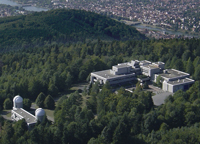|
|
Max Planck Institute for Astronomy Text: Jakob Staude and Klaus Jäger
The Max Planck Institute for Astronomy
(MPIA) in Heidelberg is one of about 80 institutes of the Max Planck
Society. Its establishment in 1967 was based on the realization that a
supraregional institute equipped with powerful telescopes would be
needed in order to be internationally competitive in astronomical
research. Together with the Center for Astronomy at the University
(ZAH) and the Department of Astro- and Particle Physics at the MPI for
Nuclear Physics, it constitutes a worldwide renowned center of
astronomical research in Heidelberg.
The Institute, completed in 1975, is dealing with the preparation and analysis of astronomical observations and the development of new measuring methods. From 1973 to 1984, it pursued together with Spanish authorities the establishment of the German-Spanish Astronomical Center (DSAZ) on the Calar Alto Mountain near Almeria (Andalusia). This largest observatory on the European continent is now used by astronomers of both countries on equal terms. Together with partners from Germany, Italy, and the US, MPIA is currently involved in the already much advanced construction of the Large Binocular Telescope (LBT) and its instrumental equipment. The LBT is located on the 3190 m high Mount Graham near Tucson, Arizona; two primary mirrors of 8.4 m diameter each are fixed on the telescope's mount, making it the world's largest single telescope. Moreover, MPIA is participating significantly in the instrumental equipment and use of the European Very Large Telescope (VLT) and the Very Large Telescope Interferometer (VLTI) on Cerro Paranal in Chile. Since it was established, MPIA has also been active in the field of extraterrestrial astronomical observations using satellites and space probes. While the data collected 1995-1998 with the European infrared satellite ISO are still being analyzed and astronomers are busily observing with the US-American SPITZER Space Telescope, the development of measuring instruments for the European HERSCHEL Space Telescope and for the James Webb Space Telescope - the successor to the HUBBLE Space Telescope, which is also intensely used by MPIA scientists - is going full steam ahead. Designing and building measuring instruments for large ground-based and space observatories are not the only tasks of MPIA, though: our own independent research is essential. Here, a close cooperation of scientists and technicians is typical for our work since addressing new astronomical questions often also requires to solve new technological problems. Two fields of scientific research are given priority at MPIA. One is the formation and evolution of stars and planets in our cosmic neighborhood. This also concerns the question: Is the Sun with its life-harboring planet Earth unique or can conditions suitable for life also be found around other stars, at least around the numerous solar-like ones? The second research focus at MPIA, galaxies and cosmology, is on a better understanding of the evolution of the present-day highly structured universe with all its galaxies and stars and how it developed from a simple initial state shortly after the big bang. In order to analyze the light received, methods of digital photography, photometry and spectroscopy are employed in the visible and infrared spectral range and continually developed further. Theory working groups complement the observing programs by model calculations, and at the University of Jena our team "Laboratory Astrophysics" investigates the optical properties of astronomically relevant materials. MPIA is in close contact with the University of Heidelberg, a number of Institute members being professors there. Students in the Department of Physics and Astronomy can attend practical research courses and do their diploma or doctoral thesis at MPIA. Scientific results are continually published in international professional journals.
MPIA employs a staff of about 190, including about 100 scientists and
technicians as well as 50 junior and visiting scientists from home and
abroad.
Contact Max-Planck-Institut für
Astronomie
|
|||||||||||||||||||||||

